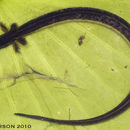Description
(
Inglês
)
fornecido por AmphibiaWeb articles
A slender and elongate aquatic salamander lacking hindlimbs. The lack of hindlimbs is a feature of sirens and dwarf sirens (Family Sirenidae). Other features of sirens and dwarf sirens are lack of eyelids and the presence of a horny beak on the upper and lower jaws (Martof 1974). Pseudobranchus have a single gill slit (Martof 1972 1974). There are only three toes on the front limbs, which are reduced and often hard to see. Individuals bear bushy, external gills throughout life. Adults may reach 25 cm total length, with 29-37 costal grooves (Martof 1972; Petranka 1998). The tail is about 40% of the total length (Martof 1972). There is sexual dimorphism, with females reaching adult size about 28% greater than males (Netting and Goin 1942; Petranka 1998). Adult P. axanthus have a brownish black to light grey ground color and parallel yellow or tan stripes on the back and sides. The stripes run from the head to the tip of the tail (Petranka 1998).The two recognized subspecies may be distinguished by differences in coloration and number of costal grooves. Pseudobranchus a. belli, the Everglades dwarf siren, has 29-33 costal grooves, three narrow, light lines within the mid-dorsal stripe, and two wider, buff-colored bands along the sides of the body. Pseudobranchus a. axanthus, the narrow-striped dwarf siren, has 34-37 costal grooves, a gray ground color, lacks well-defined light stripes and has poorly defined, grayish lateral stripes. Descriptions from Petranka (1988).Hatchling size is 10-11.5 mm snout to vent length (14.5-16 mm total length) (Petranka 1998).Juveniles differ from adults in the presence of a dorsal fin which extends from the base of the head to the tail tip. (Martof 1972; Petranka 1998).Prior to 1993, a single species of dwarf siren was recognized (e.g. Conant and Collins 1991). Moler and Kezer (1993) studied the chromosomes of Pseudobranchus striatus and split it into two separate species with different chromosome complements: Pseudobranchus striatus (n = 24) and Pseudobranchus axanthus (n = 32). The two species are found in sympatry in northern and mid-Florida, although they seem to prefer different micro-habitats. Pseudobranchus axanthus occur in open ponds and marshes, and P. striatus in cypress swamps. In addition, P. axanthus are commonly found in mats of floating water hyacinth and P. striatus are never found in water hyacinth, preferring a different floating plant called frog's bit (Limnobium spongia) (Moler and Kezer 1993). Within P. axanthus there is evidence of intergradation between the two subspecies (Moler and Kezer 1993).
- Martof, B. S. (1972). ''Pseudobranchus, P. striatus.'' Catalogue of American Amphibians and Reptiles. Society for the Study of Amphibians and Reptiles, 118.1-118.4.
- Martof, B. S. (1974). ''Sirenidae. Sirens.'' Catalogue of American Amphibians and Reptiles. Society for the Study of Amphibians and Reptiles, 151.1-151.2.
- Moler, P. E., and Kezer, J. (1993). ''Karyology and systematics of the salamander genus Pseudobranchus (Sirenidae).'' Copeia, 1993, 39-47.
- Netting, M. G., and Goin, C. J. (1942). ''Descriptions of two new salamanders from peninsular Florida.'' Annals of the Carnegie Museum, 29, 175-196.
- Sever, D. M., Rania, L. C. and Krenz, J. D. (1996). ''Reproduction of the salamander Siren intermedia Le Conte with especial reference to oviducal anatomy and mode of fertilization.'' Journal of Morphology, 227, 335-348.
- autor
- Meredith J. Mahoney
Distribution and Habitat
(
Inglês
)
fornecido por AmphibiaWeb articles
This species is distributed throughout peninsular Florida, occurring in open marshes, prairie ponds, and other permanent and semi-permanent aquatic habitats (Moler and Kezer 1993; Petranka 1998).Individuals are frequently found in floating mats of water hyacinth, a plant introduced to the region (Moler and Kezer 1993; Petranka 1998).
- autor
- Meredith J. Mahoney
Life History, Abundance, Activity, and Special Behaviors
(
Inglês
)
fornecido por AmphibiaWeb articles
Courtship and mating have not been observed (Petranka 1998). Fertilization is presumed to be external (Martof 1972 1974; Sever et al. 1996).Eggs are deposited singly, and the oviposition period lasts from early November through March (Petranka 1998).Often locally abundant. Diet consists of aquatic invertebrates, including earthworms, amphipods, chironomids, and ostracods. When semi-permanent pools dry, dwarf sirens aestivate in burrows 10-30 cm underground. Individuals are likely to be preyed upon by birds, turtles, alligators, and aquatic snakes. When disturbed, dwarf sirens sometimes emit a high-pitched yelp. See Petranka (1998) and references therein.
- autor
- Meredith J. Mahoney
Life History, Abundance, Activity, and Special Behaviors
(
Inglês
)
fornecido por AmphibiaWeb articles
There is no evidence that populations of this species are declining. However, the habitat of dwarf sirens is threatened, and therefore populations are at risk, by development and agriculture which lead to the destruction of wetlands (Petranka 1998).
- autor
- Meredith J. Mahoney
Relation to Humans
(
Inglês
)
fornecido por AmphibiaWeb articles
Dwarf sirens are sometimes seen in the pet trade.
- autor
- Meredith J. Mahoney

